Interested in growing onions? This onion growing guide will answer all your questions about seeding, planting, growing, curing and storing an onion crop. Wow that sounds dull. How about, HOLY CRAP YOU'RE GOING TO KNOW MORE THAN ANYONE ABOUT GROWING ONIONS!!!! Yes. Much better.
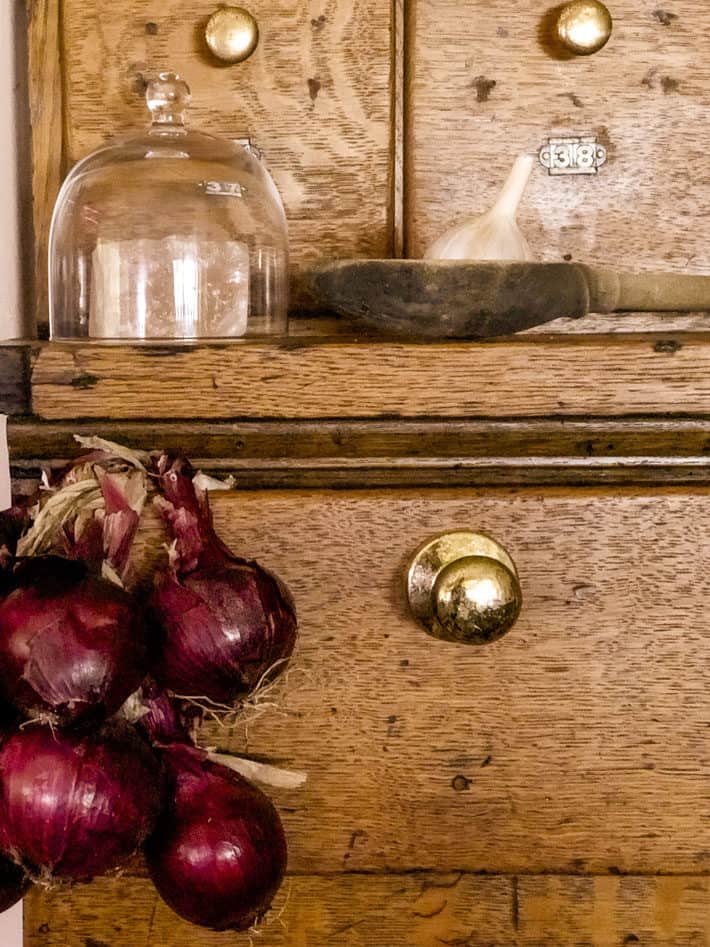
If you plant your own vegetables, growing onions is the first thing you get to do in the spring after a long winter of flipping through seed catalogues and binge watching Monty Don.
If you think it's a bit early to start onions, chances are it's actually EXACTLY the right time. Trust me on this. It's ALSO the exact right time to plant leeks. If you're growing them this year THIS is my absolute best tip for growing leeks based on an Elliot Coleman technique.
Table of Contents
When to Plant Onions
Onion seeds should be started 12-14 weeks before the last day you expect frost in your area. You can then transplant the onion seedlings outside 4 weeks before the last day you expect frost in your area.
- If you're in Zone 6 like me, your last frost date is May 10th.
- Onion seed planting day is 12 weeks prior to that - February 22nd.
- Planting onion seedlings outside date is April 19th.
Of course this is all based on predicting weather which is about as accurate as applying makeup while wearing mittens. Even a big difference in time zones only makes a difference of a week or two. (say you're a zone 3 compared to my zone 6)
Just hit Google to find your last frost date based on where you live and then click here on my seed calculator to see when you should plant everything from tomatoes to beets.
How do you plant onion seeds?
Like any other seed, you basically just stick the seed in dirt. Or "soil" for the more refined gardeners among you. BUT growing onions is different than growing other vegetables depending on where you live because where you live dictates what type of onions you grow.
Onions can be divided into 3 categories depending on how much light they need to form a bulb (that's the onion part.)
Short Day Onions
- These onions start to form bulbs when there's 10-12 hours of light a day.
- Should be grown in areas where the length of daylight remains fairly constant throughout the year.
- Best grown in areas with a latitude of 25-35 degrees North.
- Can be grown in more Northern regions but won't do as well or get large because the extreme length of light per day will trigger them start forming bulbs when their tops aren't big enough to provide enough energy.
- Example: Bermuda onions
Intermediate Onions
- These onions start to form bulbs when there's 12-14 hours of light a day.
- Do well in all regions other than South Florida or Texas.
- Can be grown almost anywhere but do best in latitudes between 32-42 degrees North.
- Example: Candy onions
Long Day Onions
- These onions start to form bulbs when there's 14-16 hours of light a day.
- Should be grown in Northern States or Canada.
- Do best in areas with a latitude of 37-47 degrees North.
- Typically the best storage onions.
- Example: Copra onions
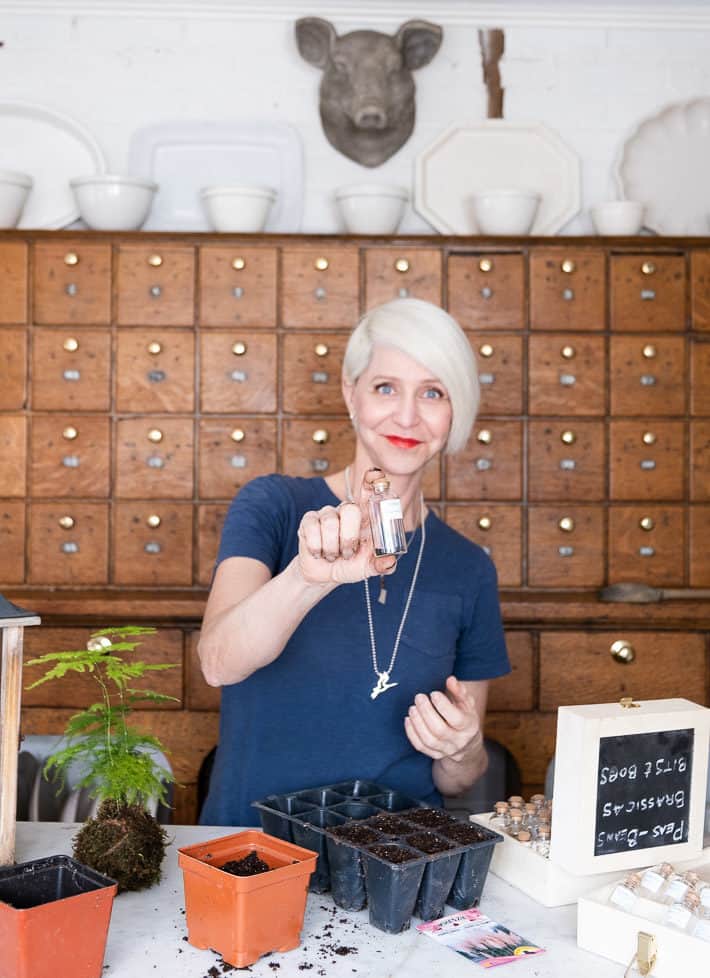
I know that's all very confusing but if you're buying seeds from a local seed seller chances are they'll be selling you the proper type of seed for your area.
If you're really confused look at it this way:
What Type of Onion You Should Grow
If you can wear shorts most of the year, you should be growing short day onions.
If you own a snow scraper, more than one winter coat and rock salt for your sidewalk, you should be growing long day onions.
Everyone in between? You're intermediate onioners.

There are 2 methods for planting onion seeds.
Winter Sowing
If you want to try winter sowing which requires no special equipment you can read my post about winter sowing here.
or
Growing under lights
This year I'll be growing my onion seedlings under lights.
You can learn about the lights I use and other seed starting tips in this post.
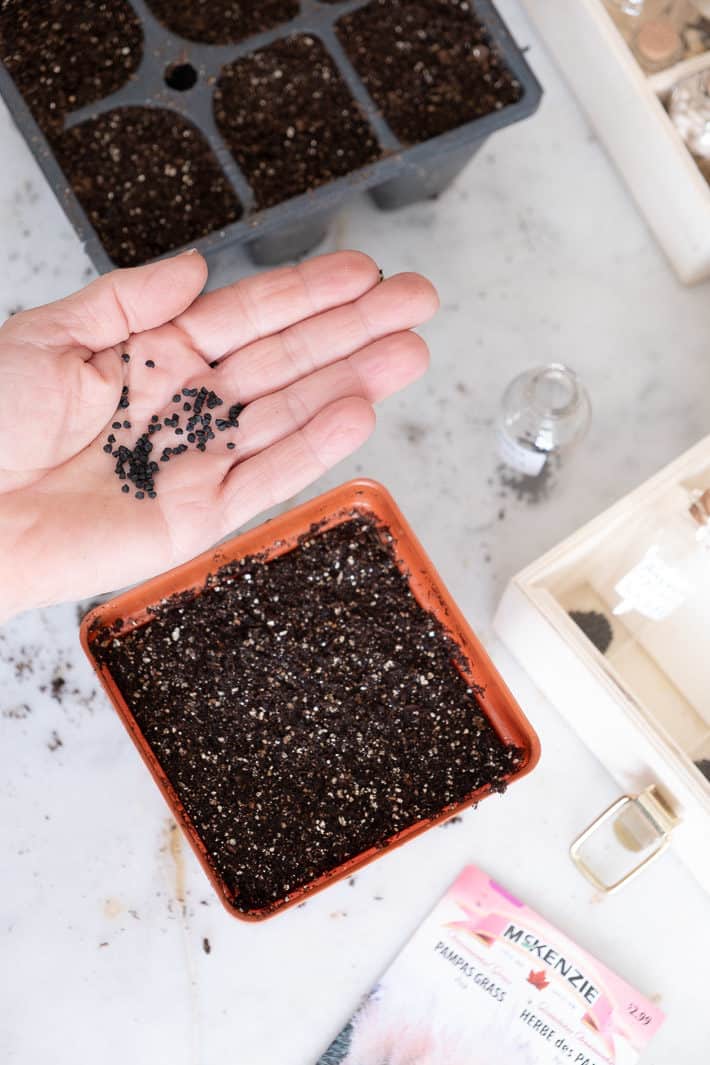
If you have NO idea how to plant seeds read this post I wrote on how to start vegetable seeds first. It describes everything you need to know from how wet your soil should be to the materials you'll need.
How to Plant Onions from Seed
- Make sure you're planting the right type of onion seed for your region. If you're planting in a "short day" onion zone, you can plant them directly outside. If you're planting "intermediate" or "long day" onions you should start them under grow lights.
- Scatter many seeds onto a 4" pot filled with pre-moistened seed starter mix. (Around 1 teaspoon of seed)
- Cover seeds with ⅛th" of seed starter mix.
- Cover pot with plastic wrap or a small plastic tray to stop moisture from escaping.
- Set pot on a heating mat or place somewhere warm like on top of a fridge or heated floors.
- Check daily on the seeds and once they start to sprout remove the dome. Under the right conditions onion seeds will sprout in around 8 days.
- Set the sprouted seeds under grow lights.
- For intermediate type and long day type onions leave the grow lights on for 11 hours a day. Don't leave them on any longer than that or you'll trigger them to start forming onion bulbs (which you don't want).
- 5 weeks prior to your last frost date, start hardening your onions off outside. You can read about how to harden off plants in my post here.
- 4 weeks prior to your last frost date (and after hardening off) plant your onions seedlings.
How Long Does it Take For Onions To Grow?
Green onions can grow to maturity in as little as 30-40 days.
Regular bulb onions take 4-5 months to grow.
Growing onions is just the start of it because after you grow them you have to cure them. It's easy, don't worry.

When planting your seeds make sure they have good contact with the soil. Press them in with your hand.
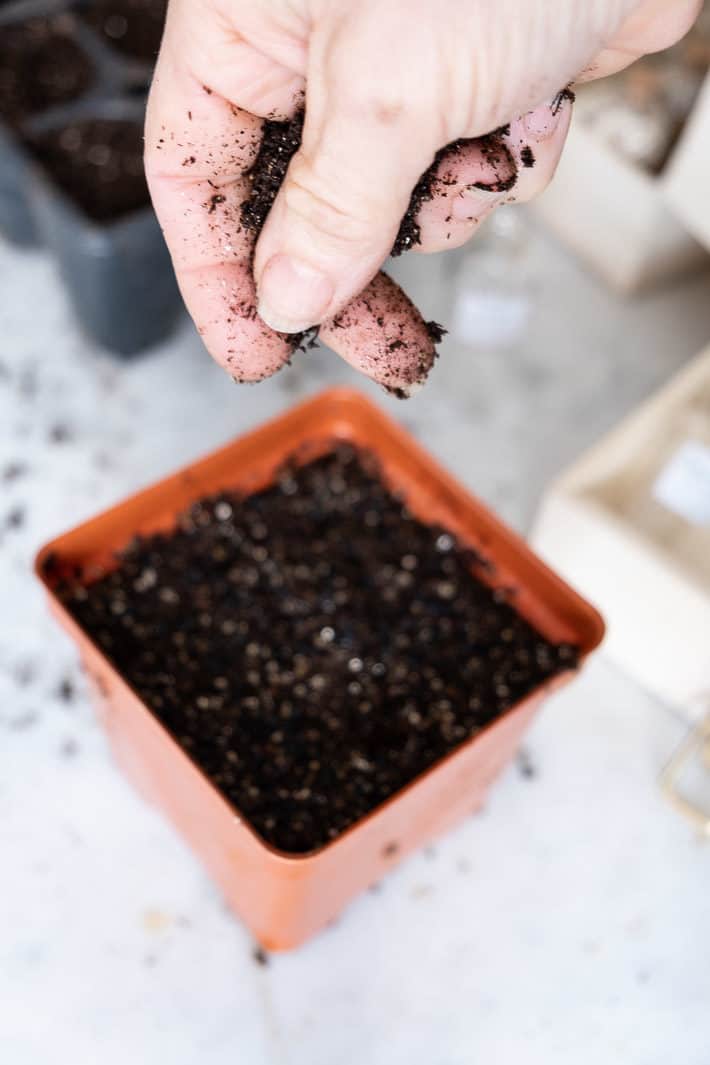
Would you like to save this stuff?
After scattering a fine layer of soil overtop, tamp that down too so it's also in close contact with the seeds.

Within 8 days or so you'll see the seeds sprouting like this. It's a very exciting day and never EVER ceases to thrill me.
Sometimes the onion seedlings have trouble popping their little heads up and remain in loops like this. If yours do that you can just cut the loop in half where it bends and the seedling will keep growing. No harm done and it's safer than trying to dig out the tip of the seedling.
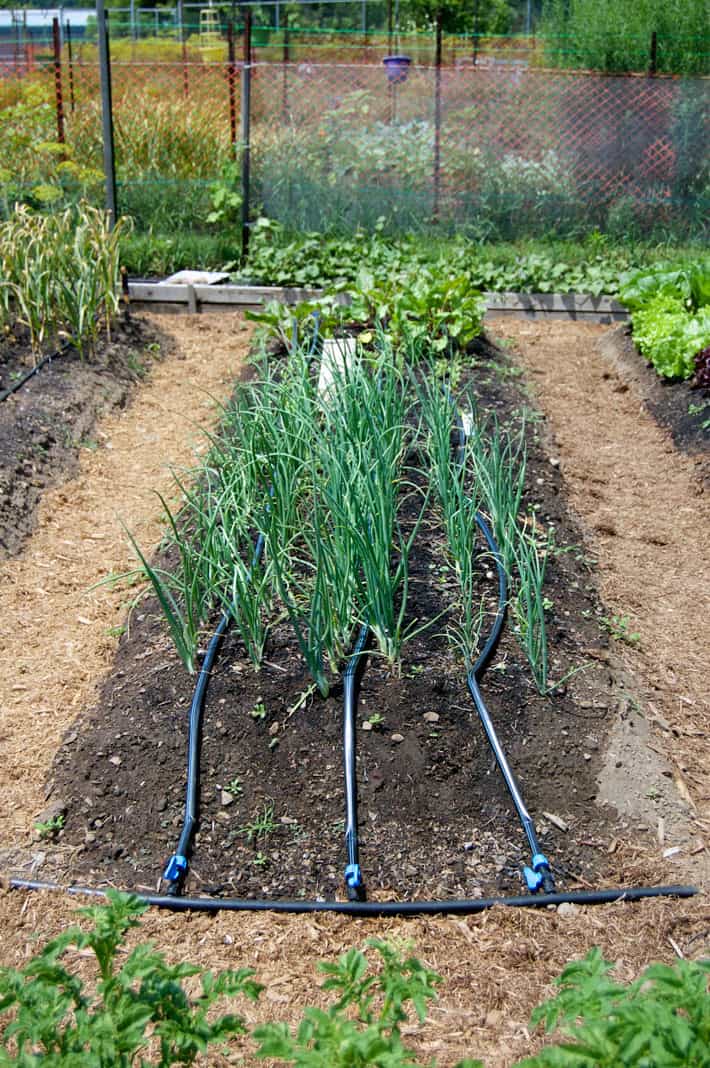
After planting them out make sure your onions have regular water and if you're worried about pests cover them for the season with floating row cover. It'll help control thrips, leaf miners and onion maggots.
Onion maggots are the real killers. They burrow into the leaves, and eat their way down to the forming bulbs leaving a rotting neck and killing the onion.
Healthy pest free onions have straight, strong, solid green leaves. Onions with pests have scarred leaves.
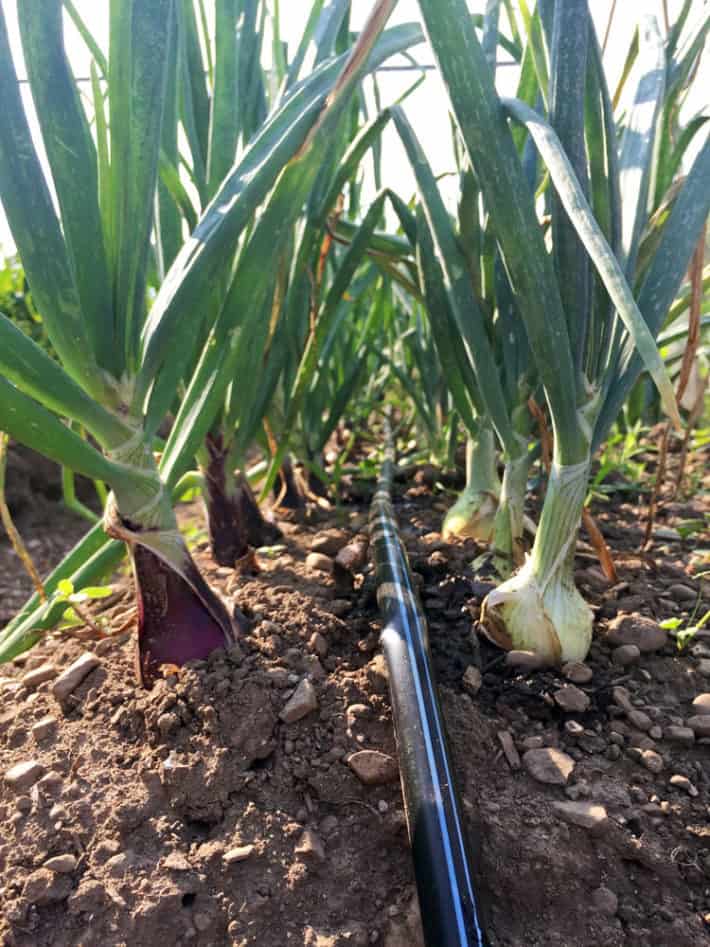
Pest damage on this crop didn't ultimately harm the bulbs.

But the damage to these onions became known to me when I went to pick them and their necks were complete mush from pests and the bacteria they bring.
The BEST way to prevent any of this damage is to cover your crop with a floating row cover as soon as you plant them.
Curing Onions for Storage
If you've grown onions from seed you want to make sure they're going to last and aren't going to rot away to a disgusting blob after spending all that time nurturing them.
That's where curing onions for storage comes in. Curing onions dries them out gradually so the necks properly cure and get dried out which prevents rot later on.
The best temperature for drying onions is 75-85 degrees Fahrenheit.
The best humidity for curing onions is 70%.
To cure onions lay them in a single layer out of the sun, but still in open air like in a garage or porch for 2-3 weeks to cure properly.
The entire neck and stems of the onion will dry out completely. At this point you can cut the stem and leaves off, leaving 1-2" of stem.
Store cured onions in a ventilated container like cotton mesh bags.
The best temperature for storing onions long term is between 32 - 36 Fahrenheit.
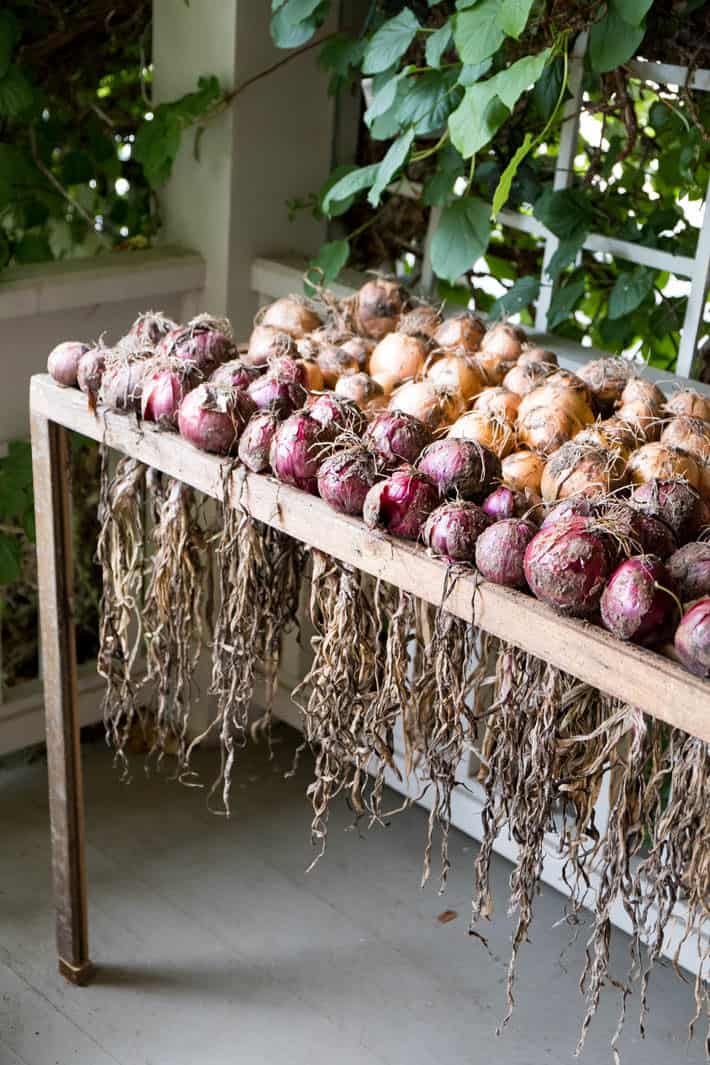
Get the instructions for how to make this herb/onion drying rack here.
Onion Storage Tips
- Onions that have very thick necks when you pick them are called "Bullnecks". The necks of these onions don't shrivel down and dry well, so it's best to use them and not use them for long term storage.
- If you don't have room in your fridge for storing your onions all season, store them in the coldest room of the house or (your garage if it doesn't freeze.)
- Don't store onions and potatoes together. The onions cause the potatoes to rot faster, but the reasoning behind why is mixed. Some people say it's because of the ethylene gas emitted by the onions and other say it's because of the high humidity both of the vegetables contain. Either way - just store onions and potatoes separately.

The Complete Guide to Growing Onions.
How to successfully grow onions from seed to storage.
Materials
Instructions
- Make sure you're planting the right type of onion seed for your region. If you're planting in a "short day" onion zone, you can plant them directly outside. If you're planting "intermediate" or "long day" onions you should start them under grow lights.
- Scatter many seeds onto a 4" pot filled with pre-moistened seed starter mix. (Around 1 teaspoon of seed)
- Cover seeds with ⅛th" of seed starter mix.
- Cover pot with plastic wrap or a small plastic tray to stop moisture from escaping.
- Set pot on a heating mat or place somewhere warm like on top of a fridge or heated floors.
- Check daily on the seeds and once they start to sprout remove the dome. Under the right conditions onion seeds will sprout in around 8 days.
- Set the sprouted seeds under grow lights.
- For intermediate type and long day type onions leave the grow lights on for 11 hours a day. Don't leave them on any longer than that or you'll trigger them to start forming onion bulbs (which you don't want).
- 5 weeks prior to your last frost date, start hardening your onions off outside. You can read about how to harden off plants in my post here.
- 4 weeks prior to your last frost date (and after hardening off) plant your onions seedlings.
Notes
- Don't forget to water! Onions (or anything) will die if you don't water them.
- You can cut the tops of your onion seedlings off when they're all around 3" high. This makes them less tangled and messy which improves their growth habit.
- Fertilize the onions as soon as you plant them with a combination of bone and blood meal. (your box or bag will have guidelines for how much but it's basically just a sprinkle around each plant)

Look at how dopey and happy I look planting onion seeds. Don't you want to be that dopey looking too?? Just grab a packet of seeds, some soil and a container and get your hands dirty and you'll be on your way.
If you really want to up your dopey face game now is also the time for you to start peas, leeks, parsley and spinach.
→Follow me on Instagram where I often make a fool of myself←






Cairle Ault
I've had terrible luck germinating leeks. I get new seed every year but only get about a 10% germination rate while my onions and shallots do fine. Any thoughts?
Avery Marie
This was VERY helpful thank you so, so, much i am doing a science fair and this showed my the bulk of how to do my experiment!!!!
Julia
When do I pick the onions? They look beautiful now and the leaves are still straight. Googling it I'm getting confusing answers.
Karen
You'll know when the onions are ready to pick because they'll start going limp at the neck and the leaves will start looking like they're ready to die back. When that's the case you can push the necks of all the onions down to the ground to help speed up the dying back part. I usually leave mine in the garden like that for a week or so before pulling them. ~ karen!
Todd Verity
Karen, What type of irrigation system do you use between rows? I cannot decide on how to irrigate my onions. I have one 8' x 4' raised bed full of onions. The pics you have look like something I could install. Thanks.
Todd
Karen
Hi Todd. You can read all about my drip irrigation system here .. https://www.theartofdoingstuff.com/drip-irrigation/ I love it, it works great. ~ karen!